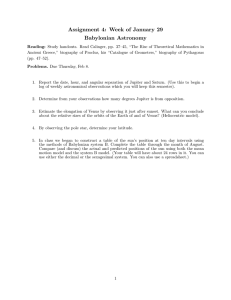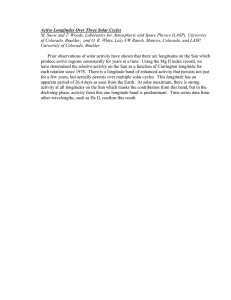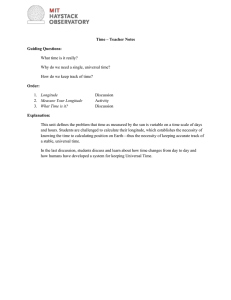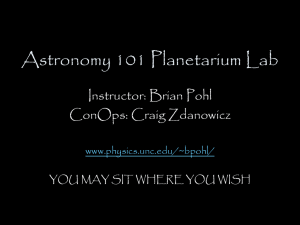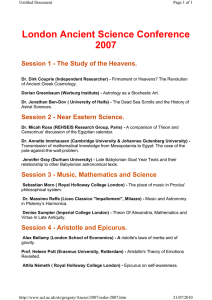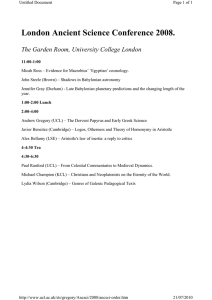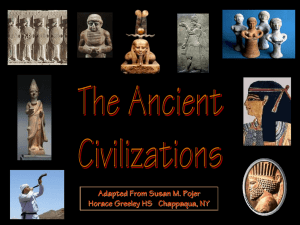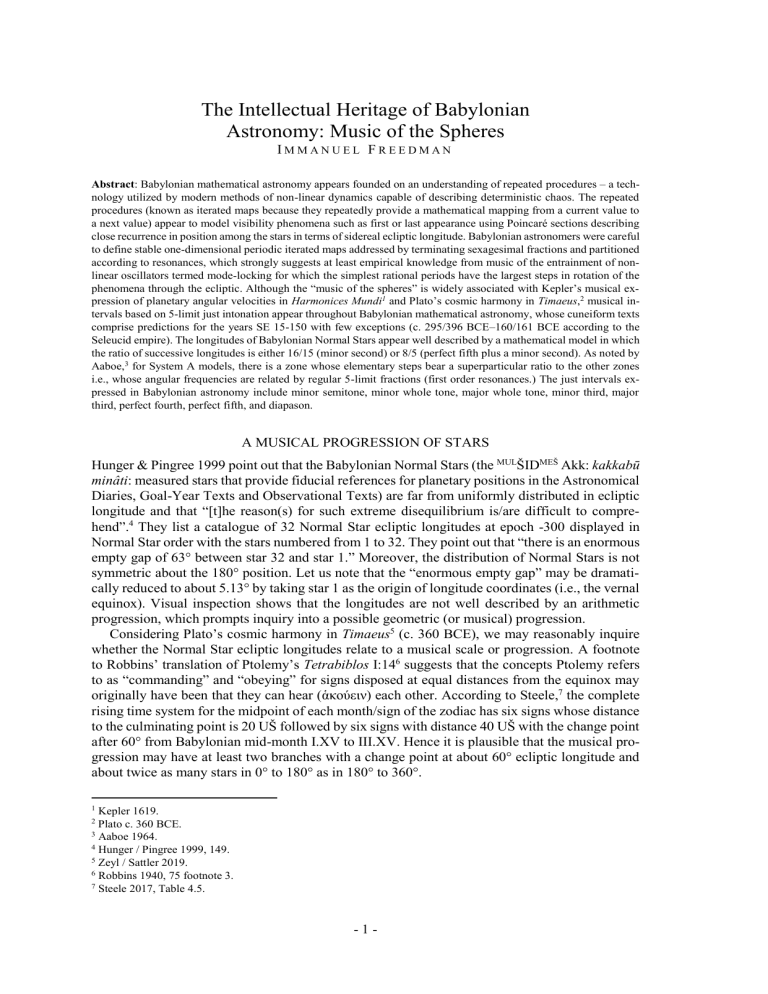
The Intellectual Heritage of Babylonian Astronomy: Music of the Spheres IMMANUEL FREEDMAN Abstract: Babylonian mathematical astronomy appears founded on an understanding of repeated procedures – a technology utilized by modern methods of non-linear dynamics capable of describing deterministic chaos. The repeated procedures (known as iterated maps because they repeatedly provide a mathematical mapping from a current value to a next value) appear to model visibility phenomena such as first or last appearance using Poincaré sections describing close recurrence in position among the stars in terms of sidereal ecliptic longitude. Babylonian astronomers were careful to define stable one-dimensional periodic iterated maps addressed by terminating sexagesimal fractions and partitioned according to resonances, which strongly suggests at least empirical knowledge from music of the entrainment of nonlinear oscillators termed mode-locking for which the simplest rational periods have the largest steps in rotation of the phenomena through the ecliptic. Although the “music of the spheres” is widely associated with Kepler’s musical expression of planetary angular velocities in Harmonices Mundi1 and Plato’s cosmic harmony in Timaeus,2 musical intervals based on 5-limit just intonation appear throughout Babylonian mathematical astronomy, whose cuneiform texts comprise predictions for the years SE 15-150 with few exceptions (c. 295/396 BCE–160/161 BCE according to the Seleucid empire). The longitudes of Babylonian Normal Stars appear well described by a mathematical model in which the ratio of successive longitudes is either 16/15 (minor second) or 8/5 (perfect fifth plus a minor second). As noted by Aaboe,3 for System A models, there is a zone whose elementary steps bear a superparticular ratio to the other zones i.e., whose angular frequencies are related by regular 5-limit fractions (first order resonances.) The just intervals expressed in Babylonian astronomy include minor semitone, minor whole tone, major whole tone, minor third, major third, perfect fourth, perfect fifth, and diapason. A MUSICAL PROGRESSION OF STARS Hunger & Pingree 1999 point out that the Babylonian Normal Stars (the MULŠIDMEŠ Akk: kakkabū minâti: measured stars that provide fiducial references for planetary positions in the Astronomical Diaries, Goal-Year Texts and Observational Texts) are far from uniformly distributed in ecliptic longitude and that “[t]he reason(s) for such extreme disequilibrium is/are difficult to comprehend”.4 They list a catalogue of 32 Normal Star ecliptic longitudes at epoch -300 displayed in Normal Star order with the stars numbered from 1 to 32. They point out that “there is an enormous empty gap of 63° between star 32 and star 1.” Moreover, the distribution of Normal Stars is not symmetric about the 180° position. Let us note that the “enormous empty gap” may be dramatically reduced to about 5.13° by taking star 1 as the origin of longitude coordinates (i.e., the vernal equinox). Visual inspection shows that the longitudes are not well described by an arithmetic progression, which prompts inquiry into a possible geometric (or musical) progression. Considering Plato’s cosmic harmony in Timaeus5 (c. 360 BCE), we may reasonably inquire whether the Normal Star ecliptic longitudes relate to a musical scale or progression. A footnote to Robbins’ translation of Ptolemy’s Tetrabiblos I:146 suggests that the concepts Ptolemy refers to as “commanding” and “obeying” for signs disposed at equal distances from the equinox may originally have been that they can hear (ἁκούειν) each other. According to Steele,7 the complete rising time system for the midpoint of each month/sign of the zodiac has six signs whose distance to the culminating point is 20 UŠ followed by six signs with distance 40 UŠ with the change point after 60° from Babylonian mid-month I.XV to III.XV. Hence it is plausible that the musical progression may have at least two branches with a change point at about 60° ecliptic longitude and about twice as many stars in 0° to 180° as in 180° to 360°. 1 Kepler 1619. Plato c. 360 BCE. 3 Aaboe 1964. 4 Hunger / Pingree 1999, 149. 5 Zeyl / Sattler 2019. 6 Robbins 1940, 75 footnote 3. 7 Steele 2017, Table 4.5. 2 -1- Noting that 16/15 is a common ratio for the diatonic semitone in Babylonian musical scales according to Crickmore8 and that 3/2 defines a perfect fifth, the Normal Star longitudes (Fig. 1) are well described by a musical scale of diatonic semitones from star 5 to star 31, with a progression of minor sixths (8/5) from star 0 to star 5, each interval consisting of a diatonic semitone with a perfect fifth (8/5 = 3/2 x 16/15). This mathematical model was fitted using the nls package for non-linear least squares regression written in the R software language. The standard errors on the low and high longitude branches are about 6.2° and 7.4° respectively, somewhat less than the typical maximum difference of about 4 cubits in ecliptic longitude during the conjunctions between Normal Stars and planets recorded in the diaries. Thus, the sequence of Babylonian Normal Star longitudes forms an approximate musical progression with a change point at about 52.8° in ecliptic longitude with highly significant scaling parameters for the low and high longitude branches. The null hypothesis of no relationship is rejected at the 1% significance level on each branch with p = 5.84x10-5 and p <2x10-16 respectively. Let us note, in passing, that the Normal Star catalogue listed on the cuneiform fragment BM 46083 lists integer rounded longitudes of Stars 19–26 in our nomenclature and whose mean longitude offset from the -100 vernal equinox is 4;28±0;20° according to Huber.9 The above model, with its geometric progression of longitudes, may, therefore, have provided useful approximate positions of Normal Stars to be observed during their lunar or planetary conjunctions. While musical intervals may inspire these progressions, they do not conform to the details of any known Babylonian musical scale according to Crickmore. Hunger & Pingree10 emphasize that Roughton & Canzoneri11 identify additional fiducial stars in the modern constellation of Sagittarius and point out the possibility that the longitude differences recorded between the Normal Stars and the moon or planets may have been calculated rather than observed. They also emphasize that the Normal Stars were observed only on rare occasions and “primarily to mark the stationary points of outer planets”. They emphasize that the positional qualifiers (e.g., in front, behind, above and below) frequently encountered in the description of conjunctions in the astronomical texts do not suffice to fully visualize such events. This consideration prompts a detailed consideration of possible methods for the prediction of planetary ecliptic longitudes from sparse, noisy data. PREDICTION OF PLANETARY ECLIPTIC LONGITUDES FROM SPARSE, NOISY DATA Goal-Year Analysis Babylonian astronomy predicted planetary ecliptic longitudes using methods including goal-year analysis, e.g. Gray 2009, together with models specifically developed for Venus as well as the well-known System A and System B models for all the other classically-known planets (Mercury, Mars, Jupiter, Saturn) and the sun. Goal-year analysis, according to the extant goal-year texts, has often been portrayed as a simplistic recurrence of astronomical phenomena for a Babylonian calendar date or position among the stars (i.e., sidereal ecliptic longitude). If, however, we examine this approach from the perspective of modern mathematics, it is far from simplistic or trivial. Let us consider a predictive model based on a discrete time series of ecliptic longitudes as follows, where 𝐵(𝑖 −̂ 𝑛. 𝑌(𝑖)) denotes an observed longitude on the same Babylonian calendar date n years before 𝑩(𝒊) ≈ 𝑩(𝒊 −̂ 𝒏. 𝒀(𝒊)) Equation 1 8 Crickmore 2008. Huber 1958. 10 Hunger / Pingree 1999, 149. 11 Roughton / Canzoneri 1992. 9 -2- Equation 1 above defines an empirical autoregression with a delay of n Babylonian calendar years in which a hypothetical error term is subsumed into a historical observation. Babylonian intercalation schemes became regular according to a Metonic lunar cycle only in about 480 BCE.12 A practical method of computation with a time-varying calendar is based on converting the calendar dates into computational tithis (denoted by τ) where each Babylonian year consists of 360 tithis. Equation 1 becomes Equation 2 below where the delay τ is measured in whole tithis from the start of the lunar calendar year for which the prediction is desired i.e., including the “date-correction” before intercalation is applied ̂ 𝑩(𝒊) ≈ 𝑩(𝒊 − 𝝉) Equation 2 The tables published by Parker & Dubberstein13 provide practical conversion from intercalated Babylonian dates to Julian dates and thus Julian days in the range 626 BCE to 75 CE. Although these goal-year texts are often referred to as non-mathematical astronomy texts (NMAT), equations 1 and 2 clarify their mathematical basis as empirical recurrence relations or autoregressions, whether or not these modern concepts were fully understood at that time. Gray 2009 demonstrated that regular adjustments to the calendar days of events and sporadic adjustments to the calendar month would be required to align the extant goal-year texts with predictions based on modern ephemerides. Moreover, these adjustments appeared consistent with theoretical expectations in all the then-known almanacs and Normal Star almanacs. In particular, she concludes that the astronomical diaries provided information for the goal-year texts that were excerpted for the almanacs and Normal Star almanacs. Moreover, the planetary positions were recorded as either (a) in a sign, (b) at the beginning or end of a sign – implying an orb of about 5° or, (c) relative to a Normal Star in terms of cubits of about 2° of ecliptic longitude with the possible modifiers of in front, behind, above, below, high to the North or, low to the South. Sachs14 suggested that such information is “useless” for prediction while Ptolemy,15 in his retrospective discussion of Babylonian astronomy, listed what he considers to be flaws in the ancient records which he characterized as “crude”. Seen from a modern mathematical perspective, this information is coarse-grained rather than useless or crude, and contemporary astronomers or philosophers may have intuitively grasped that the lexical sequence of zodiacal signs forms a description of the dynamical behaviour in terms of symbols, a symbolic dynamic. This concept appears clearly present in the A1 and A2 Venus models16 that predict the position in terms of a repeated temporal sequence of longitude zones. Although Aaboe17noted the value of zodiacal signs, he considered only their arrangement into a table of counts (a histogram) noting that none of the then-known models provided an exact match. The drawback of this approach is that (a) the System A and B models do not sample the zodiacal signs uniformly since rational rotations are not ergodic and (b) he provided no well-defined way to assess an approximate match. Conversely, matching the sequence of zodiacal signs (the itinerary) has the advantage that records may be compared by lexical matching of cuneiform signs allowing for an orb in that planets on the cusp of a sign may be considered as in the same sign. It may also be reasonable to consider positions relative to Normal Star longitudes rounded to the nearest integer, e.g. as listed on the catalogue fragment BM2083. In the astronomical texts, the dates of events (Greek letter phenomena or planetary phases) are often adjusted to “ideal” dates a few days before. These ideal dates appear to be predictive and, according to Gray, 2009, unlikely to result from astronomical cuneiform text (ACT) model predictions. 12 Gray 2009, 12. Parker / Dubberstein 1942. 14 Sachs 1988. 15 Toomer 1998, 420. 16 Ossendrijver 2012, 78 Table 3.21. 17 Aaboe 1980. 13 -3- One possibility is that, rather than attempt to observe each phenomenon in the horizon mist or haze at the moment of rising or setting, the observations are extrapolated or interpolated to definite criteria, perhaps using Babylonian methods for subdivision of the synodic arc. Contenders for such criteria include (a) 15° elongation from the sun in ecliptic longitude 18 and (b) a rising or setting arc such as 14 UŠ given that the equinoxes and solstices occur on the XV day of each Babylonian month while the underlying event takes place on the I. Let us note that the modern astrological concept of combustion, in which a planet closer than 8.5º to the sun is combust while a planet 17° or less from the sun is of uncertain visibility (under the beams) 19 is related to (b) since the seasonal variation of 14 time-degrees is from about 8.4º to about 16.8º degrees according to Ossendrijver.20 Van der Waerden 1957 confirms criterion (a) for the Mars ACT models and (b) is reasonably suggested by other visibility criteria in mulAPIN expressed in UŠ and NINDA for the moon.21 That the models focus on ecliptic longitude as the single scalar coordinate may seem surprising since Babylonian astronomers were clearly aware of ecliptic latitude and declination, if only through the concepts of “going-up-and-down”22 and the well-known paths of the fixed stars (EA2, ANU, EN.LIL2). However, the planetary ecliptic latitudes are unlikely to exceed the range of about -7.5° to about +10° spanned by the Normal Stars, except possibly for Venus, so the planetary dynamical systems may be well described by 1-dimensional approximations. Furthermore, from the perspective of modern systems science, the use of a single variable to describe position on a two-dimensional torus (i.e., the sky) may be justified according to Takens’ theorem,23 which proves that N time-delayed samples of a single variable provide sufficient information to reconstruct the dynamics for an n-dimensional system if 𝑁 ≤ 𝑛 ≤ 2(𝑁 + 1). Of interest, the five phases (FA, LA, S1, S2, AR) that Babylonian astronomers observed for the outer planets provide enough information for such a time-delay embedding for their dynamics on the 2-dimensional sky sphere (i.e., support the recovery of latitude as well as longitude). Adopting criterion (a) for didactic purposes, a modern predicted long-term synodic arc (Fig. 2) in longitude from each first appearance (FA) of Mars to the next in the Gregorian calendar range -13200/5/6 to 17191/3/14 exhibits a next-angle plot.24 We see that this next-angle plot (phase-plane plot) forms an automorphism of the circle (circle map) with a broad attractor. It is a mathematical mapping, a first recurrence (Poincaré) plot formed by intersection of the planetary motion in longitude over time with a family of transverse surfaces defined by whole numbers of FA events. Let us consider a Mars “long cycle” of 284 lunar years beginning in year -626, obtained by combining shorter approximate cycles of 47 and 79 years to approximately cancel their net rotations. This analysis requires at least an intuitive understanding that the net motion of a combination of shorter cycles (pseudocycles25) can almost cancel the net motion of a much longer cycle. The modern theory of pseudocycles relates to the modern concepts of ergodicity and ensemble in that a single long trajectory of motion may fairly sample an entire phase space comprising multiple shorter trajectories. A first recurrence plot for a synodic arc corresponding to this long cycle (Fig. 3) in the time frame SE 1 to SE 285 referred to the SE 1 epoch has width about 1 degree, within the apparent rounding errors of the Normal Star longitudes. Interestingly, although there is much debate over whether Babylonian astronomers quantified precession, it seems clear that 18 Bruin / Vondjidis 1971. Lilly 1647. 20 Ossendrijver, Fig. E1, 534. 21 Watson / Horowitz 2011, 202. 22 Steele 2003. 23 Takens, 366-381. 24 These are predictions for the Mars barycentre according to the highly accurate National Aeronautics and Space Administration (NASA) DE 431 ephemeris implemented by the Skyfield package in the Python programming language. 25 Cvitanovič. 19 -4- they were aware of the concept of epoch in which a sidereal fiducial marker indicates the approximate position of an equinox such as a fixed star e.g., Aldebaran, Antares or η Tau (in the Bristle), or any planet or the moon when it rises almost due east and sets almost due west26. The diaries include planetary data in terms of zodiacal sign, whether the planet is located at the beginning or ending of the sign and the dates of entry into and exit from the signs. Some of the records refer to ideal dates of phenomena that differ by a few days from the recorded date or are used to impute dates when the observer did not watch (NU PAP). Swerdlow27 introduces a fundamental relation between the number of events of a particular phenomenon (Π), the number of zodiacal revolutions of the event (Z) and the number of zodiacal revolutions of the sun (Y) (i.e., sidereal years), that may all be obtained, in principle, by counting. 𝑖𝛱 = 𝑌 − 𝑍 Equation 3 The mathematical concept of rotation (or winding) number is far from trivial and if Π and Z are rational, especially if they are co-prime as in Babylonian astronomical models, the rotation is mode-locked with the long-term average rational rotation number given by Equation 4. 𝛱 𝑃= Equation 4 𝑍 If P is irrational, the sequence of longitudes would be dense on the unit circle and topologically conjugate to a pure rotation.28 Moreover, the irrational case may be reached as the limit of successively refined rational rotations. The irrational rotations are ergodic in the sense that every part of the phase space is fairly sampled while the mode-locked rational rotations relate to planetary longitudes that progress according to the elementary steps in each zone and are not ergodic. Swerdlow29 suggests that “the dates must be not only true, but correct, a very demanding condition often not fulfilled by the ‘true’ dates in the Diaries.” We can refute this requirement by considering recurrences in the signs and in the beginning and end of signs that Gray 2009 noted as being consistent with the 0°–5° or 25°–30° of a sign (i.e., a cusp with 5° orb). Since the Normal Star catalogues appear accurate to about 1° in longitude, it seems reasonable that positions could be measured to better than ±5° and, equivalently for a slow-moving planet, dates (or ideal dates) estimated to within about ± 5 days (or tithis). The above modern calculations for Mars indicate that recurrences in signs suggest a minimum of N=7 events between successive returns to the same sign (the candidates are 7, 8, 15, 32 or 47 events). If we apply the well-known Babylonian sidereal year of 12;22;28 months of 30 tithis of 1 1 the System A lunar and planetary theories, the sidereal year would comprise 365 4 + 100 𝑑 = 365.26𝑑. Recurrence analysis based on Mars whole signs or cusps suggests candidate periods of 15, 17, 32, 47, 79, 126, 205, 284 or 363 years after integer rounding. This analysis appears robust to uniform random errors in date in the range [-5, 5] Julian days. Let us further note that Aaboe30 pointed out that all the then known System A periods could be expressed in the form of Equation 5 below (although he only discussed the case with the minus sign and the period for Mars requires the plus sign). 1 1 𝑃 = 𝑁 ± 𝑟 + 𝑟∙𝑠 where r, s, are non-negative 5-smooth integers, r, s ≤10 Equation 5 In modern terms, these are truncated Engel expansions and relate directly to Egyptian fractions via a table of reciprocals. All rational numbers are known to have a unique Engel expansion and two terms suffice to approximate P to 1%. If we restrict candidate base periods to less than 100 sidereal years, the only available candidates are 32, 47 and 79 years, with 79 years expressed as the linear combination 79=32+47 years. Moreover, 284 and 363 years are linear combinations of 47 and 79 years with 284 years = 47+3*79 years and 363 years = 47 = 4*79 years, and they appear in both lists of candidate periods. The only remaining steps are to confirm that a “long period” of 284 or 363 years results in the approximate cancellation of the net rotation and delay from the 4726 Freedman 2015. Swerdlow 1998, 57. 28 Denjoy 1932. 29 Swerdlow 1998, 59. 30 Aaboe 1964. 27 -5- and 79-year periods. A modern analysis31 shows that the net rotation and delay for exact oppositions of Mars after 284 years or 363 years are (-1.287°, -1.306d) or (1.061°, 1.076d) respectively. Since the 363-year period is not practically more accurate than the 284-year period, the 284-year period may be, and indeed was, selected. Of passing interest, a 647-year period (647 = 284+363) results in the almost exact cancellation of net rotation and delay (-0.226°, -0.229d). Thus, the exact correct dates of events are not required provided the distribution of errors is random of either sign, and the 47, 79 and 284 year periods emerge naturally from the diaries and the above technical constraints. These periods result in a Mars System A periodicity of P= 2,13/18 that approximates the FA average synodic arc to better than 0.1%. The Mars 284-year “long period” appears intended to provide a refinement of the 47- and 79year periods and is implemented into Mars System A models as a periodic boundary condition that may relate to what modern analysis would consider to be a prediction horizon. Truncating the Engel expansion and adopting the long period implies that 284 years is the longest cycle to be considered in a harmonic analysis based on a concept of recurrent cycles, in the same spirit as modern cycle expansions of non-linear dynamics.32 Also, let us note that the Babylonian planetary models implicitly treat a simple “three-body problem” when they describe the apparent motion of a planet relative to that of the sun observed from the earth. Furthermore, imposing strict periodicity results in tractable models by comparison with the closely written mathematics that describes a generalized two-zone map.33 The presence of 5smooth regular coefficients and/or ratios throughout these approximate models ensures that rounding errors will not accumulate, which eliminates a challenge that is particularly relevant for modern chaotic systems based on linear maps. Now that we have introduced the Normal Stars as a musical progression and derived the mean synodic period for Mars FA based on recurrences and practical approximations of the type reported in the diaries without need for exact dates or longitudes, let us now turn to the analysis of a simple two-zone System A model for Jupiter. Let us consider an exemplary two-zone piecewise linear iterated map (Fig. 4). It is termed an iterated map in modern chaos theory because it corresponds to a mathematical mapping from the sidereal ecliptic longitude of a current event (e.g., Greek letter phenomenon) to the next. In modern parlance this is a trapezoidal circle map. In Babylonian astronomy it corresponds to a procedural description of models such as Jupiter System A1, in which the prediction (mapping) procedure may be repeated (iterated) an unlimited number of times. This model is subject to several constraints: 1. All the quantities and/or their ratios are required to be 5-smooth rational numbers (i.e., rationals with denominators divisible by 2, 3, or 5) to permit an unlimited number of iterations without rounding error in base 60 arithmetic. 2. The circle map has two zones, each of which has a linear region continuously connected to a plateau region. 3. The slopes and plateau regions are determined such that the circle map is strictly periodic with a period defined by Equation 6 below, where wi, ai denote the angular frequency and width of each of n zones. Π denotes the asymptotic average number of synodic events of a specific type in Z rotations of the event through the ecliptic. ∑𝑛𝑖=1 𝛼1 𝑤𝑖 = 𝛱 , ∑𝑛𝑖=1 𝛼𝑖 𝑍 = 6,0° Equation 6 1. The levels σ1 and σ2 typically form a superparticular ratio34 of the form (n±1)/n, where n is preferably a small positive 5-smooth integer. 2. System A models have a typical 8° offset in sidereal ecliptic longitude. 31 Frommert 2008. Cvitanovič, “Cycle Expansions”. 33 Louck / Metropolis 2012. 34 Aaboe 1964. 32 -6- The longitudes in such maps form a discrete set with successive longitudes separated by “elementary steps” whose synodic arc depends on the zone.35 In simple terms, the set of elementary steps corresponding to each zone represents a collection of angular frequencies where the motion is represented according to its harmonics, and in these models particularly the first order resonances described by superparticular ratios. In the ancient musical theory of “harmonics”,36 the strongest musical resonances (and consonances) are described by superparticular ratios with small integer denominators. The question of ideal musical notes was widely debated in antiquity, with Ptolemy37 pointing out clear differences between objective measurement (the canon, a monochord), perception and rationalization into ideal ratios. Given the modern observation that when playing two notes a fifth apart (3:2 ratio to a fundamental note) some individuals can hear a tone 2 octaves below the fundamental (Tartini or difference tone) that cannot be directly observed by measurement with an experimental instrument, such subharmonic tones are likely synthesized in the brain (the so-called missing fundamental effect) and are explained by modern science in terms of the entrainment of neurons as mode-locked non-linear oscillators that leads to superparticular ratios in a Farey sequence.38 One possible musical motivation for the angular rates of System A models, related to the “divine harmony” of Plato’s Timaeus. is as follows: The planetary events move according to “elementary steps” in each zone Larger “elementary steps” imply a faster angular rate A faster angular rate implies a higher pitch39 Pitches interact according to a harmony40 The strongest pitch interactions are the intervals of (first-order) musical resonances with smaller denominators resulting in stronger interactions. There is a cosmic harmony41 The basic musical intervals cannot be divided in half42 Hence, System A map zones should be chosen according to the notes of a musical scale. Indeed, all the musical intervals in 5-smooth just intonation are represented in the models Aaboe43studied, including unison, major semitone, major tone, minor third, perfect fourth, perfect fifth, and diapason. These tones appear to comprise a Babylonian diatonic scale e.g., išartum.44 Some of the harmonics appear to occur below the fundamental considered as the angular rate of the phenomenon that results in simple motion with elementary steps. While superharmonics may often be explained by a linear theory, subharmonics always require non-linearity. Let us assume that an ideal period of Jupiter’s First Appearance (FA) has been established as P=6,31/36. Let us consider an exemplary family of System A maps, each with this period (Fig. 5). If the fundamental σ1 = 30°, the only superparticular alternatives for σ2 with small 5-smooth denominators that reasonably relate to the range of data on synodic arcs are σ 2=36°(6/5) or 40°(4/3). Let us now construct a hypothetical scheme for deciding which of the two possible Jupiter 𝜎 6 4 two-zone maps with ratio of levels 𝜎2 = 5 𝑜𝑟 3 should be selected as an optimal model. A naïve 1 view may suggest that 4/3 should be selected since that ratio almost completely brackets the range of synodic arcs according to modern calculations with criterion 15° of solar elongation along the 35 Aaboe 1948; Aaboe 1964. Levin 1994; Solomon 2000. 37 Solomon 2000. 38 Lots / Stone 2008. 39 Huffman 2018, Fragments A19, B1. 40 Huffman 2016, Fragments 1, 5, 6, 6a, 7. 41 Zeyl / Sattler 2019. 42 Huffman 2018, Fragments A19, B1. 43 Aaboe 1964, 221. 44 Crickmore, Fig, 3. 36 -7- ecliptic. Let us consider a speculative procedure for lexical matching of the observed and predicted sequence, with planets on the cusp of a sign (5° orb) considered to be in the same sign (cf. the beginning and ending of signs considered by Gray 2009), and count the number of wrong signs. While this exact procedure is unattested, it is well within the capabilities of a literate scribe and quite like well-known practices in modern astrology that consider a planet on the cusp to be in the same sign as a planet in a neighbouring sign. Moreover, Ptolemy explicitly mentions orbs. The 6/5 map scores only 9/424 wrong signs according to this procedure (Fig. 6), while the 4/3 map scores 19/424 wrong signs. Hence, the 6/5 map should rationally be selected as an optimal two-zone map, as indeed it was, as Jupiter System A1. SUMMARY & IMPLICATIONS Superparticular ratios were a hallmark of Pythagorean thought, as was divine harmony. Perhaps, cultural interaction between Babylonian scribes and Greek Pythagoreans may have inspired the choice of superparticular ratios in Babylonian astronomy, especially in the Seleucid era of Hellenized Babylon. However, the directionality of cultural interaction is not easily determined and could be in either direction or both, as with notional Pythagoras, who studied in Egyptian and Babylonian temples before returning to Ionia to found a school of thought. The longitudes of the Babylonian Normal Stars appear to be well described in terms of musical progressions and, the “forced oscillations” of Babylonian System A models appear to be well described in terms of musical resonances. REFERENCES Aaboe, A., 1964: “On Period Relations in Babylonian Astronomy”, Centaurus (10), 213–221. —1980: “Observation and Theory in Babylonian Astronomy”, Centaurus (24), 14–35. Bruin, F. / Vondjidis, A., 1971, The Books of Autolykos, Beirut. Crickmore, L., 2008: “New Light on the Babylonian Tonal System”, in: ICONEA 2008: Proceedings of the International Conference of Near Eastern Archaeomusicology Held at the British Museum December 4, 5 and 6, 2008. Cvitanovič, P. et al., “Cycle Expansions”, in: Cvitanovic´, P. / Artuso, R. / Mainieri, R. / Tanner G. / Vattay, G., Chaos: Classical and Quantum, www.chaosbook.org. Denjoy, A., 1932, ”Sur les courbes definies par les équations différentielles à la surface du tore”, Journal de Mathématiques Pures et Appliquées 11, 333–375. Freedman, I., 2015 : “The Marduk Star Nēbiru”, Cuneiform Digital Library Bulletin 2015:3, retrieved from http://cdli.ucla.edu/files/publications/cdlb2015_003.pdf. Frommert, H., 2008 : “Mars Oppositions”, http://seds.org/~spider//spider/Mars/marsopps.html. Gray, J. M. K., 2009: A Study of Babylonian Goal-Year Astronomy, Durham theses, Durham University. Huber, P., 1958: “Über den Nullpunkt der babylonischen Ekliptik”, Centaurus 5, 192–208. Huffman, C., 2016: “Philolaus”, in: The Stanford Encyclopedia of Philosophy. — 2018: “Archytas”, in: The Stanford Encyclopedia of Philosophy. Hunger, H / Pingree, D.: Astral Sciences in Mesopotamia, Brill, Leiden NL. Kepler, J., 1619: Harmonices Mundi. Levin, F. R., 1994: The Manual of Harmonics of Nichomachus the Pythagorean, Phanes Press. Lilly, W., 1647: Christian Astrology, London. Lots, I. S. / Stone, L., 2008: “Perception of Consonance and Dissonance: an Outcome of Neural Synchronization”, Journal of the Royal Society Interface 5 (29), 1429–1434. Louck, J. D. / Metropolis, N., 2012: Symbolic Dynamics of Trapezoidal Maps, Springer NL. Ossendrijver, M., 2012: Babylonian Mathematical Astronomy: Procedure Texts, Springer. Parker, R. A. / Dubberstein, W. H., 1942: Babylonian Chronology 626 B.C.–A.D. 45, Studies in Ancient Oriental Civilization 24, Chicago, The University Press Chicago. Robbins, F. E., 1940: Ptolemy Tetrabiblos, Harvard MA. Roughton, N. A. / Canzoneri, G.L., 1992: “Babylonian Normal Stars in Sagittarius”, Journal for the History of Astronomy 23 (3), Aug 1992, 193–200. Sachs, A. J., 1988: Astronomical Diaries and Related Texts from Babylonia, Vienna. Solomon, J., 2000: Ptolemy Harmonics, Brill MA. Steele, J. M., 2003: “Planetary Latitudes in Babylonian Astronomy”, Journal for the History of Astronomy 34(3), 269– 289. — 2017: Rising Time Schemes in Babylonian Astronomy, Springer: NY. -8- Swerdlow, N. M., 1998: The Babylonian Theory of the Planets, Princeton NJ. Takens, F., 1981: “Detecting strange attractors in turbulence”, in: Rand, D. A. / Young, L.S. (eds.), Dynamical Systems and Turbulence, Lecture Notes in Mathematics, vol. 898, Springer. Toomer, G. J., 1998: Ptolemy’s Almagest, Princeton NJ. Van der Waerden, B., 1957: “Babylonische Planetenrechnung”, Vierteljahrschrift der Naturforschenden Gesellschaft in Zürich, Jahrgang 102, Abh. 2. Zeyl, D. / Sattler, B., 2019: “Plato’s Timaeus”, The Stanford Encyclopedia of Philosophy. -9- FIGURES Fig. 1 The ecliptic longitude of Babylonian Normal Stars form a progression of musical intervals. Fig. 2. The relationship between the current sidereal ecliptic longitude and the synodic arc for first appearances of Mars based on 15-degree solar elongation along the ecliptic spanning Gregorian dates from -13200/5/6 to 17191/3/14 according to a modern calculation based on the Jet Propulsion Laboratory DE431 ephemeris for the Mars barycentre. Fig. 3. The relationship between the current sidereal ecliptic longitude and the synodic arc for first appearances of Mars based on 15-degree solar elongation for the ecliptic Seleucid empire dates SE 1 to SE 285 according to a modern calculation based on the Parker & Dubberstein calendar tables and the Jet Propulsion Laboratory DE431 ephemeris for the Mars barycentre. - 10 - Fig. 4. The relationship between the current sidereal ecliptic longitude and the synodic arc for an exemplary two-zone System A model. Fig. 5. A family of System A models with 30-degree fundamental synodic arc and period P=6,31/36. Fig. 6. The selected System A relationship (6/5) between the current sidereal ecliptic longitude and synodic arc for Jupiter spanning Seleucid empire dates SE 1 to SE 285 according to the Parker & Dubberstein calendar tables. - 11 - Fig. 7. The System A relationship (4/3) that was not selected between the current sidereal ecliptic longitude and synodic arc for Jupiter spanning Seleucid empire dates SE 1 to SE 285 according to the Parker & Dubberstein calendar tables. Contact: Immanuel Freedman Freedman Patent freedman@freedmanpatent.com ORCID: 0000-0003-3382-173X - 12 -
